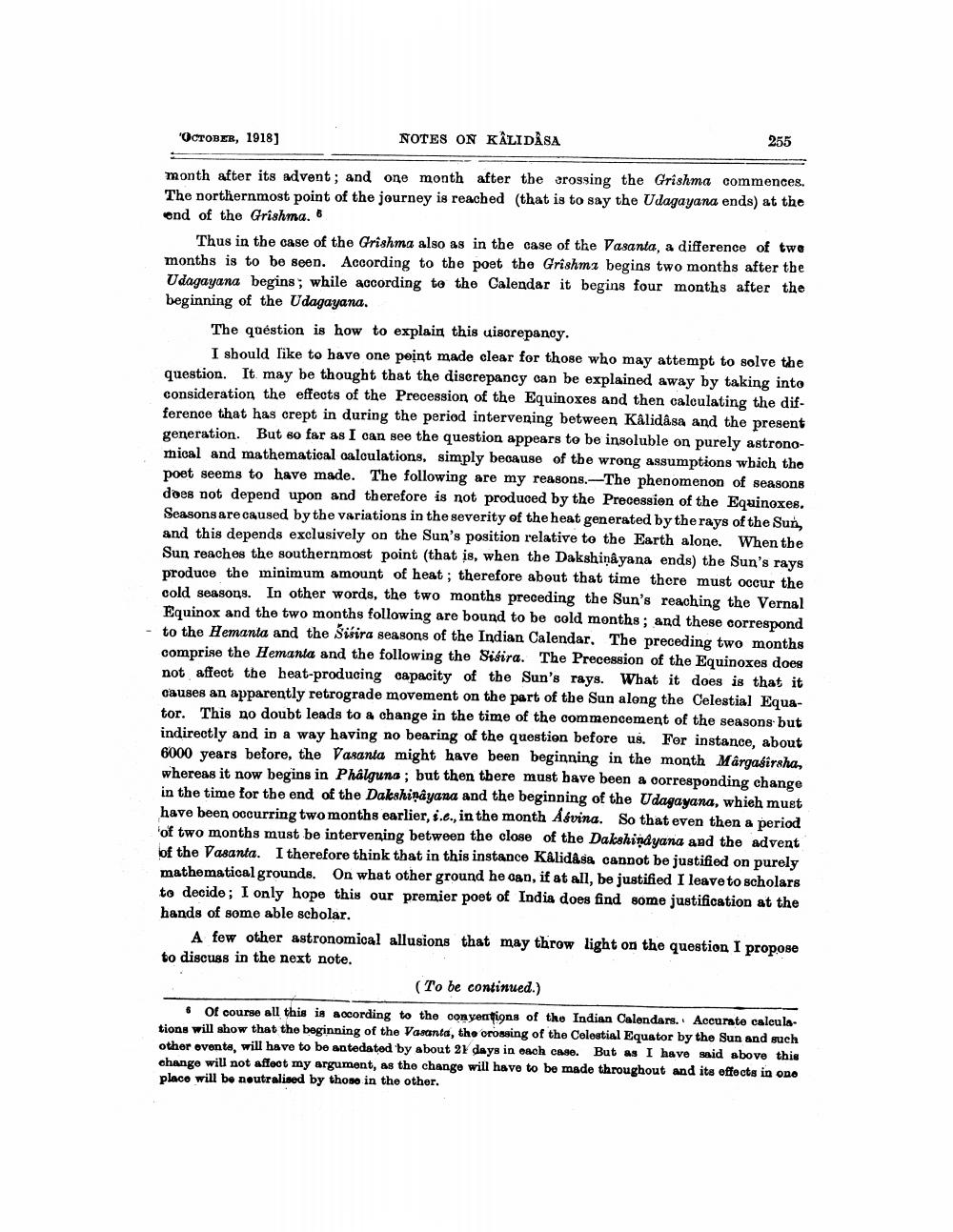________________
OCTOBER, 1918)
NOTES ON KÂLIDÅSA.
255
month after its advent; and one month after the arossing the Grishma commences. The northernmost point of the journey is reached (that is to say the Udagayana ends) at the end of the Grishma. 6
Thus in the case of the Grishma also as in the case of the Vasanta, a difference of two months is to be seen. According to the poet the Grishma begins two months after the Udagayana begins; while according to the Calendar it begins four months after the beginning of the Udagayana.
The question is how to explain this uiscrepancy.
I should like to have one point made clear for those who may attempt to solve the question. It may be thought that the discrepancy can be explained away by taking into consideration the effects of the Precession of the Equinoxes and then calculating the difference that has crept in during the period intervening between Kalidasa and the present generation. But so far as I can see the question appears to be insoluble on purely astronomical and mathematical calculations, simply because of the wrong assumptions which tho poet seems to have made. The following are my reasons. The phenomenon of seasons does not depend upon and therefore is not produced by the Precession of the Equinoxes. Seasons are caused by the variations in the severity of the heat generated by the rays of the Sun, and this depends exclusively on the Sun's position relative to the Earth alone. When the Sun reaches the southernmost point (that is, when the Dakshinayana ends) the Sun's rays produce the minimum amount of heat; therefore about that time there must occur the cold seasons. In other words, the two months preceding the Sun's reaching the Vernal Equinox and the two months following are bound to be cold months; and these correspond to the Hemanta and the Sisira seasons of the Indian Calendar. The preceding two months comprise the Hemanta and the following the Sisira. The Precession of the Equinoxes does not affect the heat-producing capacity of the Sun's rays. What it does is that it causes an apparently retrograde movement on the part of the Sun along the Celestial Equator. This no doubt leads to a change in the time of the commencement of the seasons but indirectly and in a way having no bearing of the question before us. For instance, about 6000 years before, the Vasanta might have been beginning in the month Mârgasiraha, whereas it now begins in Phálguna ; but then there must have been a corresponding change in the time for the end of the Dakshinayana and the beginning of the Udagayana, which must have been occurring two months earlier, s.c., in the month Atvina. So that even then a period of two months must be intervening between the close of the Dakshindyana and the advent bf the Vasanta. I therefore think that in this instance Kalidasa cannot be justified on purely mathematical grounds. On what other ground he can, if at all, be justified I leave to scholars to decide; I only hope this our premier poet of India does find some justification at the hands of some able scholar.
A few other astronomical allusions that may throw light on the question I propose to discuss in the next note.
(To be continued.)
6 Of course all this is according to the conventions of the Indian Calendars.. Accurate caleulations will show that the beginning of the Vasanta, the crossing of the Celestial Equator by the Sun and such other events, will have to be antedated by about 2 days in each case. But as I have said above this change will not affoot my argument, as the change will have to be made throughout and its effects in ono place will be noutralised by those in the other.




